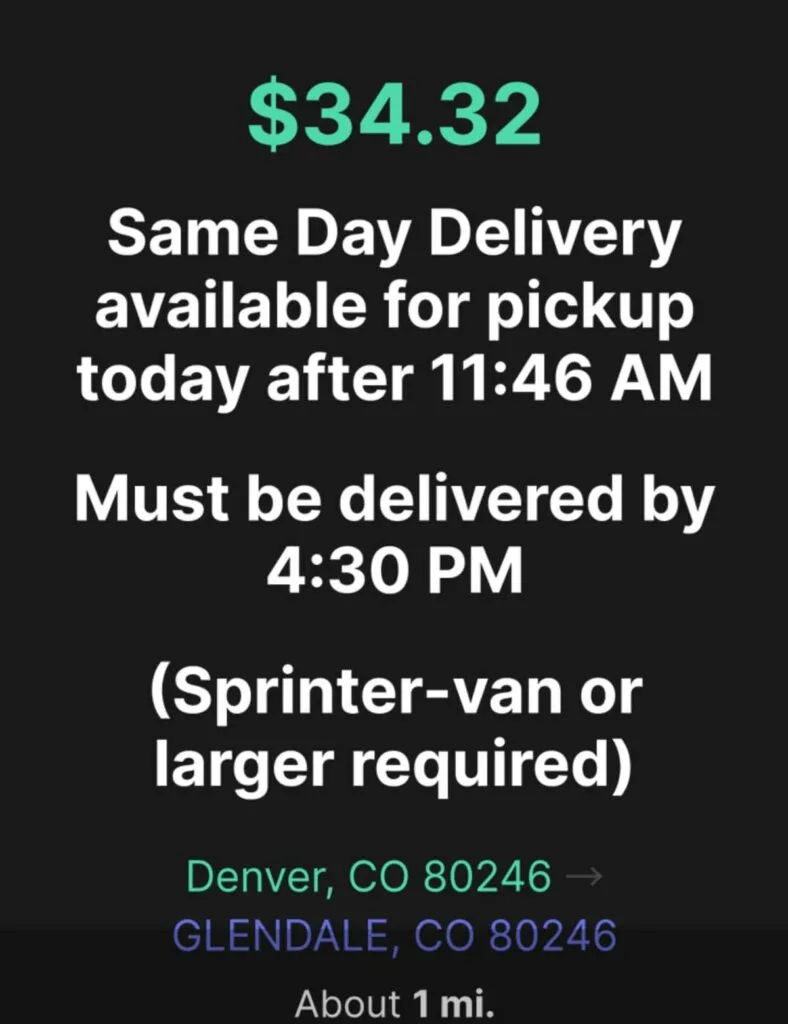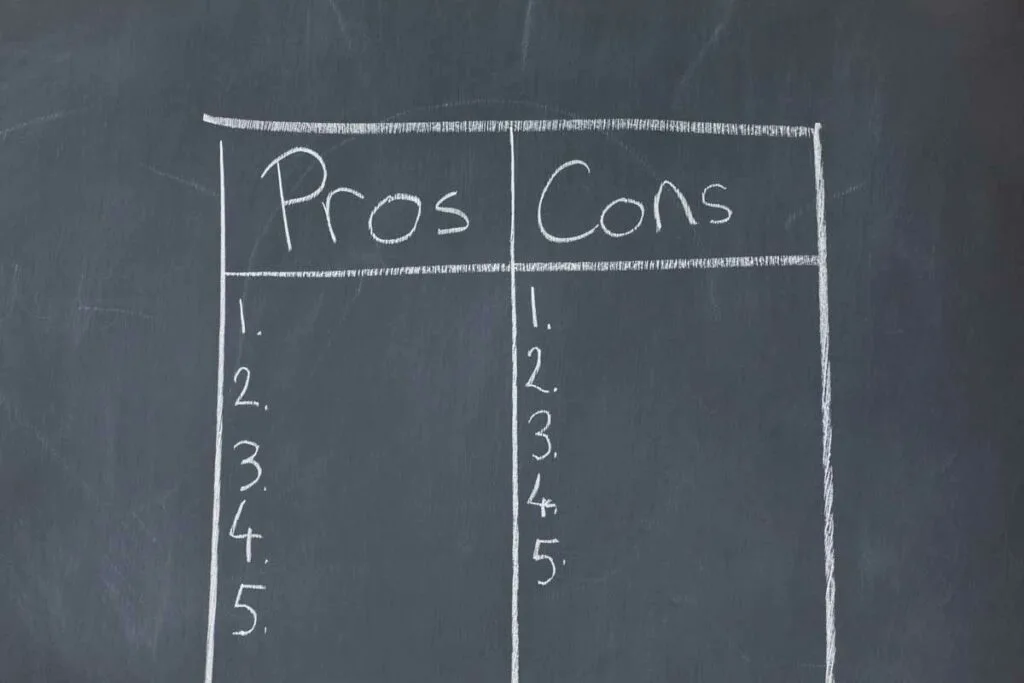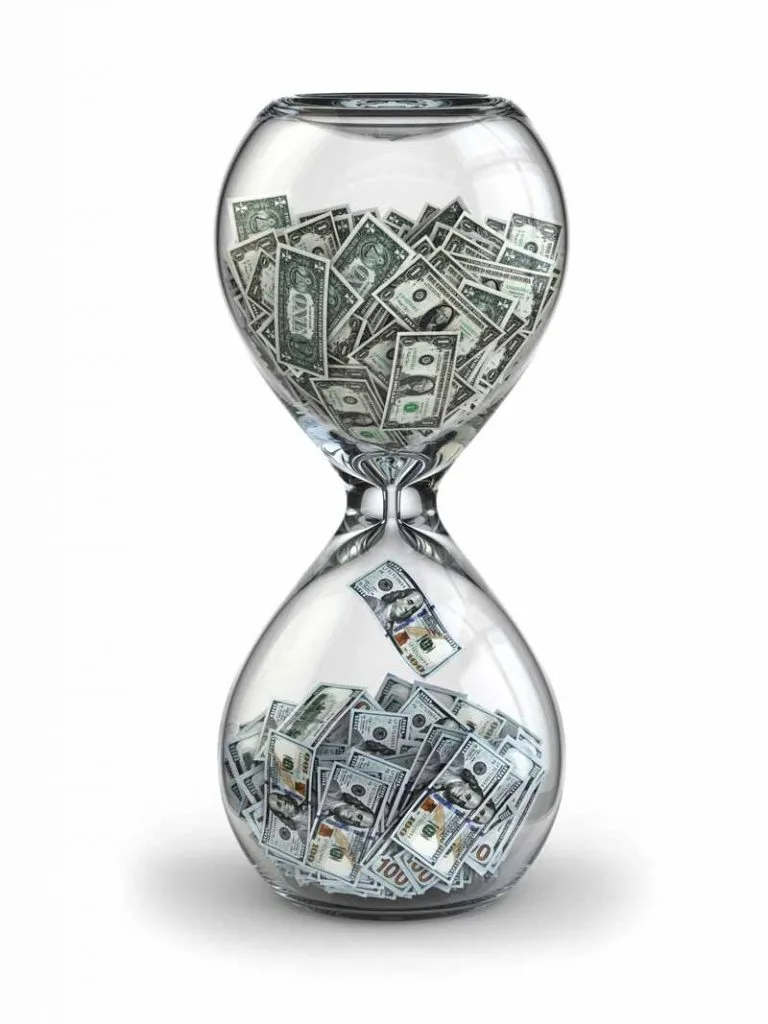Curri has sometimes been billed as the Uber of the construction supply industry.
What is Curri like for the independent contractor? Is it profitable to deliver building materials for Curri?
Do you really make more delivering for Curri than you can with Doordash, Grubhub, Uber Eats, Instacart or others?
I decided to give it a try and share my thoughts so far. Understand that this is one person’s experience in Denver, delivering with a mid size SUV (Chevy Equinox). Things may be very different for you in your market. Many of their deliveries also require a larger vehicle, and I can’t speak to what those deliveries are like.
Also keep in mind that I’m approaching this from the perspective of an on demand delivery contractor who has worked primarily with restaurant and food delivery (Doordash, Uber Eats, Grubhub).
In this review I’ll talk about:
- What is Curri and how does one sign up as a Curri-er?
- How does Curri send out offers?
- My experience with Curri offers
- My experience delivering for Curri
- Overall thoughts on delivering building supplies for Curri.

What is Curri and how does one sign up as a Curri-er?
Curri is an on demand last mile delivery platform for construction materials. They work primarily with building supply outlets (Plumbing, HVAC, Electrical, Lumber, etc.
Curri was founded by Matt Lafferty and Brian Gonzalez to meet builder supply needs in the construction industry. Trades were taking longer to complete projects because of time going back and forth to supply houses, and suppliers were losing sales because of inability to provide more flexible delivery solutions.
Curri provides a gig economy solution, using 1099 independent contractors to deliver materials on site. They work with contractors who have their own box trucks, sprinters, and vans. They also have deliveries that can be completed using pickups, SUV’s and passenger cars.
Curri has opportunities for drivers to take on a regular route for a particular supply house, and also one-off hotshot deliveries.
You can sign up for Curri here. (I am not an affiliate nor do I have a referral link for Curri). They do things differently than a lot of apps, where instead of applying on their website, you have to download the app and start the process that way.
If you have a larger vehicle, like a box truck or sprinter van, Curri would really love to have you come on board. Understand that this review doesn’t touch on the experience of delivering larger orders, as I only deliver using a mid sized SUV.
How does Curri send out offers?
The first thing I noticed is that you simply mark yourself as active on the home screen of the app. It differs from a lot of delivery apps in that it doesn’t take over your phone every time there’s an available delivery. Curri simply sends you a text and a push notification.
When you sign up, Curri has you send in a picture of your vehicle. When deliveries become available, they identify which vehicles will work. They only notify you of the opportunity if they think your vehicle is large enough.
The offers are not like with food delivery platforms like Doordash, Uber Eats, Grubhub, and a lot of others. On many of those apps, a delivery opportunity is sent only to your phone, and you can either accept or decline. If you accept on those apps, the delivery is yours.
Curri works differently. They simply notify you when a delivery is available. However, they are also notifying many other Curri-ers at the same time. You can choose to claim any delivery offer that comes available. However, claiming an offer does not guarantee you will get that delivery.
The notifications

Once you receive the notification, you have to go into the app. Another thing that is different from many of the food delivery apps is that it doesn’t just pop up with the delivery offer when you open it up. Instead, you have to tap on the menu bar then select “Requests”

From there you will see a small box with the offer. Tap on that to “claim the delivery” and you’ll get a screen with more detail.

The delivery offer does not give as much information about locations as you may be used to with the food delivery apps. All you know is the general area where you will be going. Usually you can get a pretty good idea of the time and distance you’ll be driving.
Another thing that’s very different from the Dasher or Uber driver apps: Claiming the delivery does not mean you will get the delivery. This offer is sent to several other drivers who qualify at the same time. If you tap to claim a delivery, one of three things can happen:
- You can get a message that says they’re still collecting responses and will let you know within 30 seconds if you will get the delivery
- You can get a message that says that the offer has been assigned to another driver but you can offer to be a backup.
- A message will inform you that you have successfully claimed the offer.
My experience with Curri offers
It took me awhile to finally get a delivery assigned to me by Curri. I signed up in September 2021 and finally claimed my first delivery in February, 2022.
It wasn’t for a lack of trying. Not always, anyway.
Many of the deliveries just didn’t make sense to me. When I did a quick estimate of the time and distance involved, and I figured I can make more with other delivery opportunities.
I hear often that they are the best paying gig platform out there. Based on the offers that I see, when you figure out profit per hour it just doesn’t seem to be the case. While they do seem to pay more per opportunity, the average time and distance are much longer.

An example: The largest offer I’ve seen so far.
The highest paying offer I’ve seen is from Vail to Grand Junction, 141 miles for $300.
That’s pretty attractive. Google maps tells me that would be about a two and a half hour drive.
But when I looked at the bigger picture, it wasn’t worth it.
Vail is an hour and 45 minutes, and 100 miles, from my place. The return trip from Grand Junction is 4 hours and 240 miles.
530 pounds of materials will take some time to load and unload. Overall, I’m looking at at least nine hours and 480 miles.
My SUV costs 35 cents per mile to operate. That’s something I’ve calculated that takes into account fuel, maintenance, long term wear and tear, and the impact that miles make on the resale value of my car.
What that means is, only $130 of that $300 is profit. $130 in nine hours is $14.44 per hour.
That doesn’t mean it’s a bad offer. If I live in Vail it could be more attractive. Then again, if I live in Vail, I need more than $30 per hour to afford to live there. If I’m already going that direction, it’s a fantastic offer.
But for me, as an on demand driver based in Denver, this is not a great offer.
Actually claiming deliveries can be a challenge.
I don’t receive many offers. At most I may say one or two in a day. Several days can go by without an offer.
The biggest challenge has been actually claiming an offer if I am interested. I would open the app the moment I received a notification, tap to claim it and I’d get a message that they’re still collecting responses.

It’s clear that this is not a first come, first serve system. I kind of took it as “we’re seeing if someone better might want this delivery.” It left me with the feeling that “we’re waiting for someone better to come along.”
I’m sure that’s not the impression intended by Curri. However, I don’t know if they are waiting to see if someone is closer, or if they have a preferential system.
After awhile it became a game for me, to see how quick I could respond and try to claim a delivery. In fact, when I finally received one, I had to go back into the details again to see if I really wanted to take it.
By my evaluation, most offers I saw were fair to poor when considering time to go out and back.
A lot of offers look great, but when I think about the time it will take to get them done, they’re not so good any more.
I looked at the last ten offers I received. They totaled up to $665.00.
$66.50 per delivery seems fantastic compared to frequent $2.50 Doordash offers. But then I did a quick estimate of the time and distance it would take to drive to the supplier, then drive to the drop-off point, and make a return trip.
The total distance of those ten offers was 1,200 miles. Only one was less than 20 miles. The total time it would take is 26 hours.
If I somehow managed to take all of those deliveries, my cost would be $420. That’s based on the actual cost of 35 cents per mile for my car.
For all the time and cost involved, those deliveries would net me $9.42 per hour. Minimum wage in Colorado is $12.56.
The flip side is that three of the ten offers projected to more than $25 profit per hour. They were the three shortest offers. Which says there can be some good deliveries.
To be fair, those numbers could be better depending on where I am when I start the delivery and what I’ll do afterwards. These were all based on driving to the supplier and then returning straight home. If I can get other deliveries along the way, or work my way back with other deliveries, those numbers can improve.
I did receive one route opportunity that was intriguing.
Shortly after signing up, I received a text offering a daily route.
Hey there, this is ________ with Curri.com. I have an opportunity starting this Thursday morning running a daily delivery route for 8 hours a day in our 26 foot flatbed.. Monday through Friday starting at $28/hr and we guarantee 8 hours of pay/daily payouts ($224) with OT at $37.50.
Text from Curri about a route opportunity (with some location details left out)
There’s a piece about that which looks like a fantastic opportunity. But there are some real problems in it.
I’ve been able to average right around $30 per hour profit doing food delivery. That’s my take after my 30¢ per mile car cost is factored in. This puts me right in that same ball park, and if I’m not wearing my car out, that would make it tempting.
A daily route wouldn’t fit into my schedule, so I passed. I’ll admit, it wasn’t easy to say no.
I will say there are some concerns about this arrangement when it comes to an independent contractor relationship. A set schedule, hourly pay rate, overtime pay AND using a truck provided by either Curri or the supplier is walking a fine line when it comes to employee misclassification.
The pay rate is good enough that I don’t feel like this is an abuse of the contractor relationship. However, the IRS specifically states that hourly pay and providing the materials to complete the job are evidence of control that points to an employee relationship.
This isn’t a complaint. However, I do hope this doesn’t ever become an issue for Curri in a political climate where many are trying to stop the use of independent contractors in the gig economy.
My experience delivering for Curri
As I write this, I’ve only actually delivered one time for Curri. That experience was okay.
The moment I was assigned the delivery, I had texts from Curri that asked if I had any questions. I did have a couple and someone responded right away. I was impressed by that.

There’s a button on the app that you tap that says “I’m on my way.” The app wouldn’t let me tap it, saying I couldn’t activate the delivery more than a half hour before the delivery window. It was ten minutes before I was supposed to pick up.
I kind of wish they were more clear on whether “I’m on my way” meant I’m heading to the supplier, or I’m on my way with delivery in hand.
There’s one thing I had not realized or paid much attention to before this delivery. There’s a lot more time flexibility than I realized. I could pick up between 10 and 1, and deliver by 4.
This particular delivery was to an HVAC company. It took 45 minutes from when I left to when I dropped off everything. I drove 20 miles and made $25. That’s $19 after expenses, about $25 per hour.
Of course, if I were to drive home immediately, that might cut that profit in half. However, I was able to turn on my food delivery apps and work my way back, and that worked out well.
Fifteen minutes after I completed the delivery, Curri texted and told me my payment had already been sent to the bank.
Overall, it was a pretty easy experience. I was able to do the delivery early enough in the morning that it was perfect for picking up then with food deliveries.
Overall thoughts on delivering building supplies for Curri

I think that Curri is something that you should at least look into.
Does Curri pay more than Doordash, Uber Eats, Grubhub, Instacart, etc.?
Based on my evaluation, no. In fact, the hourly profit averages far lower than what I make delivering for those platforms.
Now the average amount per delivery is far higher than I see anywhere else. But it’s an apples to oranges comparison because of how much time and cost is involved in a typical Curri delivery.
That doesn’t mean all deliveries are bad. This is also based on how I operate where I like to work in a certain region, and it’s based on the assumption that my time and driving are dedicated to the particular Curri delivery.
With all that said, I am noticing that a lot of the food delivery options are becoming less profitable. Because of that, I think it’s important that a delivery professional have as many options available as possible.
Another way to look at it is, about 30% of delivery opportunities I’ve received from Curri would pay about the profit per hour I make on other deliveries. That compares to about a 20 to 30 percent acceptance rate I usually have with Doordash, Uber Eats, and Grubhub.
I don’t see Curri as paying better by any means. The percentage of acceptable offers is comparable to other platforms.
I see Curri, Doordash, Uber Eats, Instacart, Veho and others as customers. A smart business owner diversifies their income opportunities so as not to rely on any one platform.
In the end, even with just one delivery, I appreciate having Curry as a customer. More on that in a moment.
The biggest pros of delivering for Curri.
One, Curri is an option that can offer profitable deliveries. As there’s more saturation in the gig economy delivery space, it’s harder to rely solely on one or two delivery platforms.
Two, you know exactly what you’re getting as far as pay. Sometimes it’s nice to have that assurance, especially with larger paying deliveries.
Three, most Curri deliveries seem to be more flexible. Compared to meal deliveries that need to be completed immediately, most offers with Curri are more flexible with time requirements. This makes it easier to multi-app. You could pick up your Curri delivery, and then along the way grab deliveries that are take you the same general direction.
Four, they pay immediately. It’s kind of amazing how fast they pay.
Five, there’s a personal touch with Curri. You can talk to real people, and real people are communicating with you along the way. That’s very refreshing compared to the larger food delivery groups.
Six, Curri pays far better out of their own pockets. They don’t rely on customer tips as an excuse to not pay their contractors.
Finally, if you can get a regular route, that route can be pretty lucrative and provide some nice guaranteed revenue.
The biggest cons of delivering for Curri.
When the response after you try to claim a delivery is “our system is still collecting responses” it definitely leaves the impression that there’s some favoritism happening with assigning deliveries.
For all the claims of paying so much better, I was a little disappointed with the offers I’ve seen. After factoring in time and expense, the average profit per hour is much lower than I see with food deliveries.
Curri seems to offer a lot less details to go on when evaluating an offer. It’s good that they don’t play the hidden tip game, however other details are lacking.
- The distance displayed on an offer is only from the supplier to the destination. Mileage estimates now from Grubhub, Doordash, and Uber Eats all include the total distance you will drive.
- Curri actually provides far less detail about the pickup and drop off locations on a delivery opportunity. There is no map to help you evaluate, only the zip code.
- There’s no estimate of the time involved.
I don’t see any of those details as deal killers. With a higher pay per delivery, some of the smaller details mean less than five to ten dollar food offers. It’s not hard to estimate times and distances even with what details are provided.
Finally, there aren’t enough delivery opportunities with Curri to rely heavily on them. Many markets are saturated, and there’s a lot of competition for available deliveries. Unless you can get on a regular route, Curri may never be a source of regular or reliable income.
Three things to consider when evaluating a Curri delivery
In my mind there are three things to think about when evaluating a Curri delivery:
- How much time is it going to take?
- What is it going to cost me to deliver it?
- Can I blend this in with any other opportunities to maximize my earnings?
How much time will it take?

One thing I should point out: I evaluate Curri deliveries differently than I do meal deliveries, in a way that may be unfair to Curri.
For Doordash, I’m looking at how much time it’s going to take between when I start and when I drop off the order. I go beyond that for a Curri delivery, because I’m also counting the time it takes to come back from the delivery.
This is because many of the Curri deliveries are going far enough that it’s harder to just pick up food deliveries on the way back. That return time is dead time.
Ultimately the question is: how much time is it between when I start and when I can start on my next opportunity.
If I’m delivering 100 miles away, I have to count the time it takes to come back.
What is this delivery going to cost me?
Just like with time, I’m looking at the distance between when I start on a delivery and when I’m able to start on my next delivery. It’s not just the distance between supplier and the drop off location.
Curri deliveries are consistently much longer distances than typical meal deliveries. That’s why I think it’s more important than ever to be aware of what it costs to drive your car.
It will cost you a lot more to take that 100 mile delivery than 3 or 4 gallons of gas. Think of your car as a credit card on wheels. Every mile you drive gets you that much closer to replacing tires, timing belts, and many other items. Each mile you drive also lowers the value of your car. All of these are costs that you will pay, but it may be paid much later.
At the minimum, the operating cost of a vehicle is going to be around 20 cents a mile. 35 to 40 cents is probably normal, especially if you have a fairly new vehicle. If you’re driving around a more valuable work vehicle like a newer pickup or Sprinter van, the cost goes even higher.
Take that all into account. It’s like that $300 offer I mentioned earlier. $300 for one day sounds like a no brainer. However, at 480 miles, I know that’s costing me $144 to take that trip. That’s half my pay.
Can I blend this with other opportunities to maximize my earnings?
Most of my evaluation of Curri offers has been written with the assumption that it would be just an out and back trip. That’s because there’s not much you can do otherwise. For a food delivery driver used to working a particular zone, the longer distance drives on Curri make it harder to just pick up another delivery once done.
However, if you can piggyback your trips with other opportunities, or find a way to get a return trip, that can greatly increase the value of delivering for Curri.
I said earlier that one of the best advantages with Curri is that you have more flexibility to multi-app. The pickup and drop-off times are not always so rigid. If you communicate well with the supplier and the customer, you can often find flexibility that lest you go out of the way a bit to take on other opportunities.
That flexibility can also enable you to blend in food deliveries a bit more seamlessly.
For instance, I wrote in another article that one thing I didn’t like about delivering Veho packages was there was a specific pickup time for your route. You had to arrive at the warehouse within a certain window of time. This was also an issue in my review of delivering catering orders for DeliverThat.
Rigid pickup times create dead time for an on demand courier. You can’t take a delivery that might make you late.
The flexibility of many of the Curri deliveries can make it easier to incorporate other deliveries before, during and after. It also can keep you busy during traditional slow times, like between breakfast and lunch or lunch and dinner.
Should you deliver for Curri?
That obviously depends on how you decide is best to run your business.
It depends on a lot of things. How busy is Curri in your market? How many other options do you have (Doordash, Uber Eats, Roadie, Instacart, etc.) that can let you weave other opportunities in with Curri trips?
I’ve only done one delivery in the several months I’ve been signed on, but I still see Curri as a valuable option. It’s another arrow in the quiver. Curri is one more option, one more customer for my delivery business.
The worst thing that can happen if you sign up is you just don’t get any good offers. But every once in awhile a gem pops up
My philosophy with delivery in the gig economy is that it’s a big bidding war. I give my talents to the highest bidder. If Doordash has the best offer, I’ll take that delivery. The more the bidders, the better I can keep a steady pace of revenue flowing into my business.
You can sign up for Curri here. As of the writing of this article, you have to download their app and complete the signup process from the app. I do not receive any compensation from Curri.
Give them a try. And then let me know what you think. I always like hearing the experiences of others.


